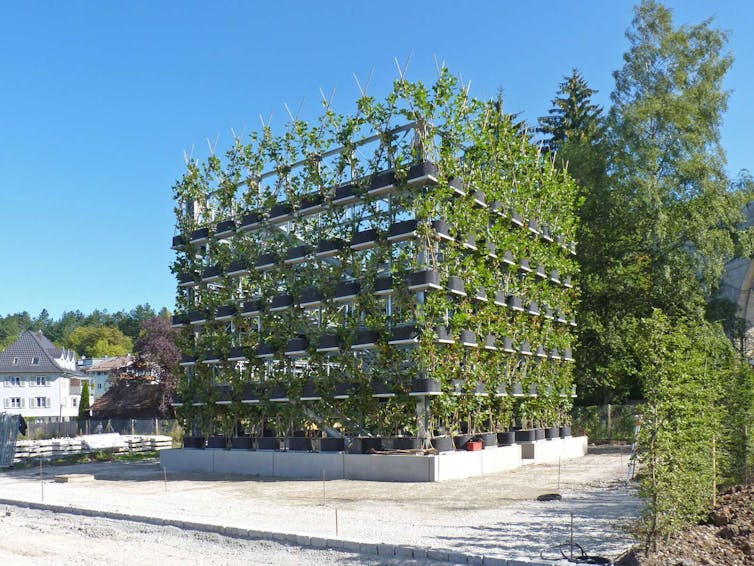Source: The Conversation – (in Spanish) – By Javier Martín Vide, Catedrático de Geografía Física, Universitat de Barcelona
La primera ola de calor del verano en España y en otros países de Europa occidental, como Portugal, Francia, Italia o Alemania, temprana en el calendario, batió récords de temperatura en el mes de junio en muchos lugares. En España, este pasado mes ha sido el junio más cálido desde 1961, en que comienza la contabilización de sus anomalías, al igual que en Europa occidental, donde ha supuesto el junio más cálido desde que se tienen registros.
Los 40 ºC se superaron con facilidad en la última semana del mes en amplios sectores de la mitad sur de la España peninsular, principalmente en Andalucía y Extremadura, y en otros lugares mucho más septentrionales, como en Orense (Galicia) o Gerona (Cataluña). Los valores extremos en los estados ibéricos fueron de 46,6 ºC, en Mora, a unos 100 km al este de Lisboa, y de 45,8 ºC, en El Granado, en
la provincia de Huelva.
Las noches han resultado insufribles, incompatibles con el descanso nocturno, en los centros de las ciudades mediterráneas y de la mitad sur de España y Portugal. El caso de Barcelona es muy significativo: en el barrio del Raval todas las noches de la última decena de junio fueron tórridas, es decir, con temperaturas mínimas de 25 ºC o superiores, y han continuado así hasta los primeros días de julio.
Las aguas del Mediterráneo muestran también unos valores exageradamente elevados para el momento del año. Son equivalentes a los récords de agosto de los últimos dos veranos. Y hay que pensar que la gran inercia térmica del agua prácticamente asegura que esta anomalía térmica marina durará todo el verano y hasta bien entrado el otoño. En este sentido podemos afirmar que el calor seguirá, al menos en las aguas marinas y en los espacios litorales e insulares.
Leer más:
El océano se sofoca
Toda Europa se calienta
También fuera de la península ibérica las temperaturas alcanzaron valores récord para el mes de junio, como en el norte de Alemania, en diversos lugares de Francia o en el Ártico noruego. Un potente anticiclón en altura con intrusión de aire del sur, sahariano, ha sido la causa de esta ola de calor temprana.
Gráficamente, el anticiclón supuso la tapadera de una enorme cúpula o domo de aire cálido, que ha cubierto la península ibérica y buena parte de Europa occidental. El persistente anticiclón ha ocurrido en los días con mayor insolación potencial, por ser los más largos del año y en los que el sol alcanza la mayor altura sobre el horizonte.
Es difícil saber si en el presente verano habrá más olas de calor. Las predicciones estacionales para el trimestre julio-agosto-septiembre indican que la probabilidad de que tenga una temperatura media superior a la normal es elevada, superior al 70 %, tanto en España como en gran parte de Europa. En los últimos veranos la ocurrencia de varias olas de calor en el sur de Europa ha sido la norma.
Efectos en la salud
El exceso de calor, diurno o nocturno, tiene una repercusión negativa en la salud humana. Los humanos somos animales homeotermos, de temperatura interna casi constante, entre 36,5 y 37 ºC. Cuando el exterior alcanza valores próximos o superiores, no nos sirve la vasodilatación cutánea, “ponernos rojos”, es decir, aumentar la sangre circulante por la periferia para desprender calor. Si el ambiente está a mayor temperatura, como el calor siempre se transfiere del cuerpo más caliente al de menor temperatura, el aire nos contagiará calor. Nos queda entonces un último mecanismo termorregulador para mantener la temperatura interna en sus límites: la sudoración.
No existe otro animal que tenga un número de glándulas sudoríparas ni una tasa de sudoración tan altos como los humanos. El sudor, formado por agua y sales minerales, al evaporarse desde la piel, produce, como toda evaporación, un enfriamiento. Naturalmente, habrá que reponer el agua bebiendo abundantemente, so pena de deshidratarnos.
Alimentos como el gazpacho, y las ensaladas nos aportan agua y sales. Igualmente, las frutas (melón, sandía, etc.) son recomendables y apetecibles en tiempo cálido.
Además de la deshidratación, los golpes de calor son efectos muy peligrosos del exceso de calor. Cuando la persona es incapaz de mantener su temperatura interna constante y se va elevando hasta alcanzar valores que superan los 40 ºC, se desvanece y requiere atención médica urgente. Cae en coma y los daños pueden ser irreversibles.
Durante esta última ola de calor, se han producido en varios países muertes por golpe de calor y otras, bastante más numerosas, también atribuibles a las altas temperaturas, aunque de forma indirecta, por agravamiento de enfermedades crónicas. En particular, las personas de edad avanzada y con enfermedades crónicas son muy vulnerables al calor, especialmente si están en condiciones de
pobreza energética. Es decir, si no disponen de un aparato de aire acondicionado. No descansan bien por la noche, se debilitan y aumenta su morbilidad: los ingresos hospitalarios, y también, desgraciadamente, su mortalidad. Es un problema de salud pública.
Leer más:
El calor excesivo perjudica seriamente la salud, ¿pero cómo?
Finalmente, aunque los países del sur de Europa son los expuestos con
mayor frecuencia e intensidad a valores muy altos de temperatura, la
adaptación al calor extremo debe ser también prioritaria en los países del centro y norte del continente, menos habituados a las olas de calor. La mayoría de los apartamentos y hasta los servicios públicos de estos países no disponen de aire acondicionado. Ni el modo de vida, ni la aclimatación al calor se corresponden con temperaturas exageradamente altas.
![]()
Javier Martín Vide no recibe salario, ni ejerce labores de consultoría, ni posee acciones, ni recibe financiación de ninguna compañía u organización que pueda obtener beneficio de este artículo, y ha declarado carecer de vínculos relevantes más allá del cargo académico citado.
– ref. Radiografía de la primera ola de calor del 2025: ¿qué podemos esperar para el resto del verano? – https://theconversation.com/radiografia-de-la-primera-ola-de-calor-del-2025-que-podemos-esperar-para-el-resto-del-verano-260752

















